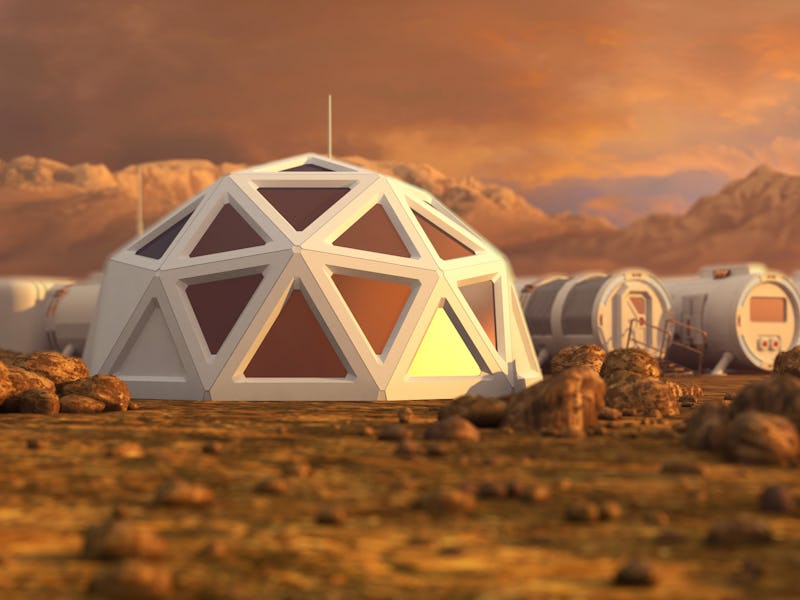A Mars city built with human blood bricks? We have the technology!

As we head into the weekend, we have four mind-expanding stories for you. The first one is about how human biomass could be used to bond Martian soil together to make bricks for future developments on the red planet (Cue up the Soylent Green reference).
Another story is on how a trip to an amusement park led to a scientific breakthrough in the pursuit of cleaner water for more people.
Also in this daily dispatch: A forecast of what will come after this week’s historic Inspiration4 mission. Finally, we present an original, completely true story of how Steven Spielberg was this close to having a raptor named after him — until it fell apart at the very last minute.
Incredible stuff in this one. Enjoy.
I’m Nick Lucchesi, and this is Inverse Daily. Please share this science & innovation newsletter with a friend by sending them this link.
This is an adapted version of the Inverse Daily newsletter for Friday, September 17, 2021. Subscribe for free and earn rewards for reading every day in your inbox. ✉️
Mars may be built with human blood — Jenn Walter reports that researchers have made a surprisingly strong building material from a combination of human blood, sweat, tears, and dust. It could help construct buildings on Mars:
For all the glitzy depictions of future Mars civilizations, there’s one glaring problem: How do we even begin to build a city on Mars? Transporting a single brick from Earth to Mars is estimated to cost as much as $2 million. Imagine what it’d cost to build a research station — or just a modest space to sleep.
A team of researchers from the University of Manchester has an unorthodox solution.
Go deeper:
- See if you can spy this Mars Easter egg snapped by NASA’s Ingenuity
- ExoMars rover: The next big Mars mission is taking off
- Elon Musk says a Mars city of 'glass domes' comes first
At Ocean Park Hong Kong you can enjoy food, amusement — and scientific breakthroughs.
A clean water breakthrough — Sarah Wells speaks with scientists in Hong Kong who have discovered the strange water-bending property of the Araucaria plant, and transformed it into a water-controlling technology:
Zuankai Wang, who is a professor of mechanical engineering at the City University of Hong Kong, tells Inverse that it was at Hong Kong’s Ocean Park that his postdoctoral fellow, Feng Shile, became fascinated by the unassuming Araucaria plant — a type of evergreen with stiff and densely packed needles or petals.
Studying the leaf’s strange curvature, which is formed by tightly packed curved needles nested onto each other, the pair quickly realized there was something even more unusual lying within. Namely, an intrinsic ability to control the flow of fluids on its surface without exerting any external energy.
Go deeper:
- These artificial cells can clean up your drinking water
- Landmark tool could help us find water on other planets
- This futuristic water filter could let you drink seawater
The SpaceX Falcon 9 rocket carrying the Inspiration4 crew launches from Pad 39A at NASA's Kennedy Space Center in Cape Canaveral, Florida on Wednesday.
Life on Mars? After Inspiration4, what’s next — Mike Brown hears from astronaut Garrett Reisman, who helped develop SpaceX's Crew Dragon capsule. Reisman has a bold vision of the future of space:
Reisman explains that SpaceX will use the Crew Dragon capsule for a series of missions planned by Axiom Space. The space company plans to build its own private space station, using the ISS as its starting point before eventually detaching after building out far enough. The first mission is scheduled for no earlier than January 2022, and subsequent missions are planned to occur every six months thereafter.
But Crew Dragon could be phased out soon by Starship, the fully-reusable rocket first unveiled by Musk in 2017. This ship, expected to host its first orbital test this year, is designed to send over 150 tons or 100 people into space at a time.
Go deeper:
Sign up for Musk Reads+, our premium newsletter with original content
Spielberg with a Panaflex camera on the set of Jurassic Park in 1993.
Spielberg's raptor: The wild, true story — Brian Vanhooker writes how Jurassic Park led to (and then killed) Stephen Spielberg's chance to have a dinosaur named after him:
“You just found Spielberg’s raptor!”
Paleontologist Robert Bakker’s exclamation to his colleague, Jim Kirkland, on the phone back in 1991 was quite literally about a big discovery.
Digging in Gaston Quarry in Grand County, Utah, Kirkland had uncovered fossils of giant newly discovered raptor. Snout to tail, the ferocious creature would’ve been about 20 feet long and six feet tall, with long, curved, razor-sharp talons on each foot measuring nearly a foot in length.
More longreads:
- The oral history of Idiocracy, Mike Judge's time travel triumph
- How Asian American internet trailblazers gave new life to Shang-Chi
- Shrek, the “ugly stepsister” that changed animation
Filmmaker Baz Luhrmann marks a birthday today.
- About the newsletter: Do you think it can be improved? Have a story idea? Want to share a story about the time you met an astronaut? Send those thoughts and more to newsletter@inverse.com.
- Notable birthdays: David Souter (82); Phil Jackson (76); Baz Luhrmann (59; pictured above); Narendra Modi (71); Doug E. Fresh (55) (Source: AP.)
- Song of the Day: “The Best” by Tina Turner, which doesn't get enough acclaim as it should.
- A technical note — To ensure your email open is counted toward our streak program, confirm that all the images have loaded and your ad blocker is turned off.